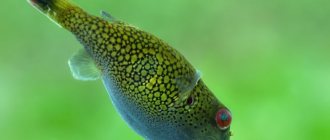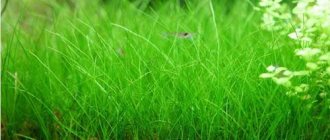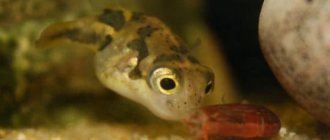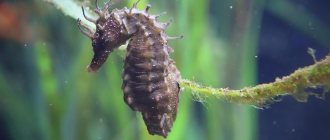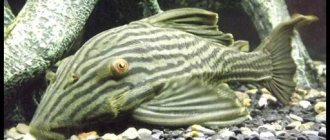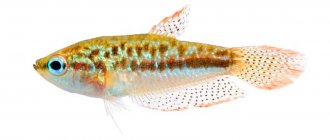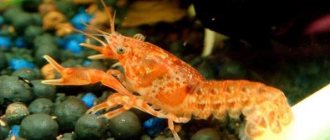Dwarf or green tetradon belongs to the pufferfish. This is the smallest representative of the family. First discovered in southern India. Lives only in fresh waters. In India, they are found in the Pamba River, the current of which is characterized by its slowness, since it flows in the mountains and flows as a waterfall into the large Vembanad Lake.
Dwarf tetradon grows no more than 25 mm. Males are larger than females and upon reaching sexual maturity they become brighter and have a black stripe on their abdomen. These fish are rarely found in pet stores, since they have only recently begun to be used as aquarium fish. But, thanks to their playful nature, beautiful bright color and small size, tetradons are becoming popular.
Description
The maximum size of the fish is 3 cm. These small predators are in demand among aquarists. Dwarf tetradons prove that in a small aquarium you can keep not only guppies, but also more exotic and unusual species of fish.
Appearance
The body of the tetradon is drop-shaped, with sharp spines that protect the fish in times of danger. The dwarf pufferfish has large eyes that can rotate in different directions. The color changes depending on the mood: from green to brown with dark spots. The abdomen is white or slightly yellow.
Behavior
Dwarf fish are very smart. If the tetradon senses danger, it swells, acquiring a spherical shape and protruding needles. Pygmy predators love to hunt for live food. They are aggressive and territorial, keeping in a flock. They don't eat plants.
Lifespan
Small fish live relatively short lives, and the dwarf tetradon is no exception. With good maintenance and care, the tetradon will live for 5 years.
Content
Dwarf tetradons are suitable for aquarists with little experience. Mandatory pet care includes maintaining stable water parameters in the aquarium.
Aquarium
For a small flock, a 20-liter container is sufficient. Remember that biological equilibrium is more difficult to establish in small vessels and they require frequent maintenance. Choose rectangular and square shaped aquariums. It is better not to use convex and round containers, since the specific shape of the walls causes stress in the fish.
Water parameters
In nature, tetradon lives in fresh water, so salt, even in small concentrations, is unacceptable. The range of water parameters in which pufferfish feel comfortable is narrow. Avoid sudden changes in temperature and hydrochemical composition of water. Periodically check the water with tests for ammonia compounds, water hardness and acidity. Perform weekly fluid changes of 20% of the total volume.
Breeding
Many species do not reproduce in captivity. It is extremely difficult to obtain offspring from others. Reproduction is stimulated by frequent water changes, increasing the temperature, and adding vitamins and microelements to the diet. These measures so rarely have a positive outcome that there are still no specific recommendations for stimulating spawning.
Tetradon reproduction process
Shar fish lays up to 500 eggs either on the substrate or simply in the water column. The male guards the eggs until the fry appear (8-9 days), after which the parents lose interest in the offspring and perceive them as food. Therefore, if the fry are successfully reproduced, it is better to transplant them into another aquarium and feed them with Artemia nauplii.
Feeding
Dwarf fish eat live food and do not accept dry food. The diet should include:
- small bloodworm;
- tubifex;
- small snails (coil, physa, melania);
- coretra;
- gammarus for fish;
- daphnia;
- squid;
- earthworms;
- brine shrimp
Serve snails regularly. Using snail shells, pufferfish wear down their rapidly growing teeth. Breed shellfish in a separate container, so tetradon will have an important component of the diet. Remember that large snails are not suitable. If your dwarf fish refuses frozen food, mix it with live food, pre-treating it in a solution of potassium permanganate, methylene blue or piperazine. Feed the fish 1-2 times a day in portions that are eaten within 2-3 minutes.
Diet for aquarium inhabitants
Keeping a tetradon in an aquarium is complicated by the fact that its teeth grow quickly, which it needs to regularly grind down, so mollusks with hard shells must be added to its daily diet.
Although green predators are omnivores, they most often choose protein foods. Under natural conditions, their diet consists of various invertebrates - shrimp, crabs - and plants. Aquarium nigroviridis are fed:
- cereals
- bloodworm,
- crab meat,
- fish fillet,
- Artemia,
- snails.
Tetradons can also be fed dry food. Experts recommend choosing Tetra brand products. The company has developed specialized food that helps enhance the color of fish. There are also options with more vitamins and mixtures made specifically for fry.
Tetradons should not be overfed. In nature, they constantly hunt to get food for themselves, but in an artificial reservoir they do not need this.
If you give insatiable fish a lot of food, they will become very fat and die at an early age.
Eats shelled shrimp, crayfish, crabs, occasionally live fish (not goldfish and livebearers), snails, and sometimes frozen food.
Compatibility
It is better to stock dwarf predators in a species aquarium. Tetradons may be compatible with herbivorous, non-aggressive aquarium inhabitants:
- zebrafish;
- iris;
- rasborami;
- corridors;
- neon.
Large species of shrimp, such as amano and cherry shrimp, are suitable for living together. You cannot house dwarf tetradons with large fish and those with long fins. Guppies, goldfish, cichlids are unsuccessful bedfellows.
Who do dwarf snailophiles get along with?
All tetradons are quite active, mobile and willful, and dwarf ones are no exception. Different owners have opposite opinions about their livability. For some, these small inhabitants coexist peacefully with other living creatures, while for others, they mercilessly eat the fins of their neighbors and terrorize them.
It is best to keep a flock of these bullies separately, without putting anyone in danger. You can add large shrimp to them, but these little pufferfish will feed on small ones. If, nevertheless, tetradons end up in a common aquarium, a spacious container with abundant vegetation will help reduce their aggression. The same applies to their individual content.
Although it is difficult to predict how these little tyrants will behave towards other inhabitants, the best company for them can be called:
- iris;
- otocinclus;
- zebrafish;
- rasborov espey;
- cherry and amano shrimp;
- Ramiresi's Apistogram;
- discus.
But it is not recommended to house yellow pufferfish with the following aquatic inhabitants:
- veiled tails;
- small shrimps;
- guppy;
- platies;
- cichlids;
- predatory catfish.
Reproduction
Tetradons are easy to propagate in an aquarium. A spawning tank will be required to preserve the offspring. Create good conditions in the spawning tank. Install a filter that will not suck in the fry or create a strong flow of water. Plant the plants.
Sex differences
Distinguish males from females by their deeper coloration and dark line on the belly. Sometimes the fins of males turn yellow. Females are larger and plumper than males.
View this post on Instagram
Analyzing their dots to try to recognize them a little #carinotetraodon#travan#carinotetraodontravancoricus#minipufferfish#minipuffer#pufferfish#puffer#fish#tank#fiahtank#tetraodontidae#tetraodontiformes#poissonglobe#poissonballon#globefish#freshwater#estuaire#eaudouce#india#indian
A post shared by LET'S GET THIS BREED (@shrimpette_) on Jul 5, 2018 at 4:00pm PDT
Spawning
A couple of weeks before spawning, feed your fish nutritious live food. Place a pair or group of fish, where there will be 1 male and several females. Tetradons spawn on plant leaves and soil. From one female you can get up to 10 eggs.
After laying the eggs, release the parents. The fry appear after 3–5 days. Starter feed:
- microworms;
- ciliates;
- Artemia nauplii;
- small snails;
- frozen food.
If several generations are growing together, sort the fry by size, as the larger ones may eat the smaller ones. By two months the fry grows to 1 cm.
View this post on Instagram
#aquarium .#aquarium .#tetradon.#tetradon .#carinotetraodontravancoricus .#dwarf tetradon#thundersnails .#snail hunter.#snail eater.#snail destroyer.#snails in aquarium
A post shared by aqualiveplants (@aqualiveplants) on Jun 28, 2015 at 12:38pm PDT
Tetradon figured
Figured tetraodon, or Tetraodon biocellatus, is the most common in Russia. This fish is imported from Southeast Asia, where it inhabits the fresh waters of small rivers and canals.
Its size does not exceed 10 centimeters. Coloring depends on the maturity and characteristics of the individual fish. The abdomen of Tetraodon biocellatus is snow-white, and the upper part is distinguished by chic patterns of yellow and green.
On the back of this fish there may be circles, stripes, spots and various lines. Typically females are less colored than males. But during spawning they can be more massive in size.
It is advisable to keep them in a separate aquarium, because the fish has a hostile disposition, and leisurely or small pets become its direct prey.
Conditions of detention. In their natural environment they live in rivers with fresh water and a temperature of 23-28°C, pH 6.7-7.7, hardness 5-15.
Feeding. The diet must include snails, crustaceans, insect larvae, tubifex and earthworms. An aquarium of 100 liters is required for maintenance.
Reproduction of fish is possible at one year of age. Spawning and care are similar to the spawning of cichlids: the pair lays eggs on a flat stone, and the male monitors and cares for the clutch.
Cucuta
Of Indian origin, this fish grows up to 100 mm in length. Unlike other tetradonts, keeping a cucoutia should not cause serious problems. The only thing to remember is the mandatory change of salted water. As for color, green is characteristic of males, while females are yellow, as shown in the photo. In addition, on the side of the body of these fish you can see a small mesh image.
They have an aggressive character and prefer to spend most of their time in the shade.
That is why it is so important that the aquarium has a sufficient number of different hiding places. It is recommended to feed them with live food, and snails are preferred as a delicacy.
Diseases
The dwarf predator has a strong immune system and rarely gets sick. A common cause of the disease is incorrect water parameters and feeding, and lack of aquarium hygiene.
Ammonia poisoning
Pufferfish produce a lot of waste, so failure to clean the aquarium on time can cause excess ammonia, which is dangerous for the fish. When poisoned, the gills are inflamed and red. Immediately clean up the aquarium and check the water for dangerous compounds. Smoothly improve water quality.
Nitrate poisoning
When poisoned by nitrates, tetradon becomes restless and fussy. The gills and fins are spread out, the fish is greedily trying to breathe. A sick individual can be placed in an aquarium with clean water with similar parameters. Carry out general cleaning in the general aquarium, check the water for nitrates.
Dropsy
The abdomen of the dwarf predator swells, the color fades. Often the disease is caused by poor quality food. Review your fish's diet.
Interesting Facts
- A dog fish's teeth grow throughout its life. Therefore, it is necessary to give snails: by breaking the shell, the tetradon grinds down its teeth;
- To make a fish swell like a ball, the easiest way is to pull it out of the water. However, this is not recommended: it is not good for the health of the fish, and the owner may get burned by the poison from the thorns on the predator’s skin;
- A special organ helps the tetradon swell: it fills with water or air, and when the danger disappears, it gradually deflates;
- Many tetradons like to bury themselves in the ground, leaving only their muzzle on the surface.
Photo
Adviсe
- Do not provoke fish to swell into a ball, because this is a protective mechanism that is accompanied by severe stress. Do not disturb the fish unless necessary, do not knock on the glass or touch them.
- If the fish behave like spawning, but you do not see eggs, walk along the ground with a small hose. There will be eggs among the drained water.
- Store-bought frozen food is not the best option, since the aquarist has no knowledge of the quality of the food and how it was stored. A safe option is to make homemade frozen food. Freezing as a method of processing fish food is very effective.
- Wash your hands when handling the aquarium. Cleaning equipment must be free of traces of detergents.
Dwarf tetradons are said to be poisonous. Large animals that eat them die due to the poisonous mucus or fish needles. If you need to come into contact with tetradon, make sure that there are no scratches or other damage on your hands.
Previous
Fish Tips for keeping a large cleaner - brocade catfish!
Next
FishWhat you need to know to breed barbs in an aquarium
Results
As already mentioned, there are a huge number of different types of tetradons. And each of them requires a special approach. So, for example, what a green tetradont prefers may not suit another species. But there are main points of content that are common to everyone. So, first of all, you should always maintain the temperature within 24-26 degrees, do not forget about aeration and in no case overfeed.
It is also recommended to learn a little about the conditions of the selected species before making a purchase.

